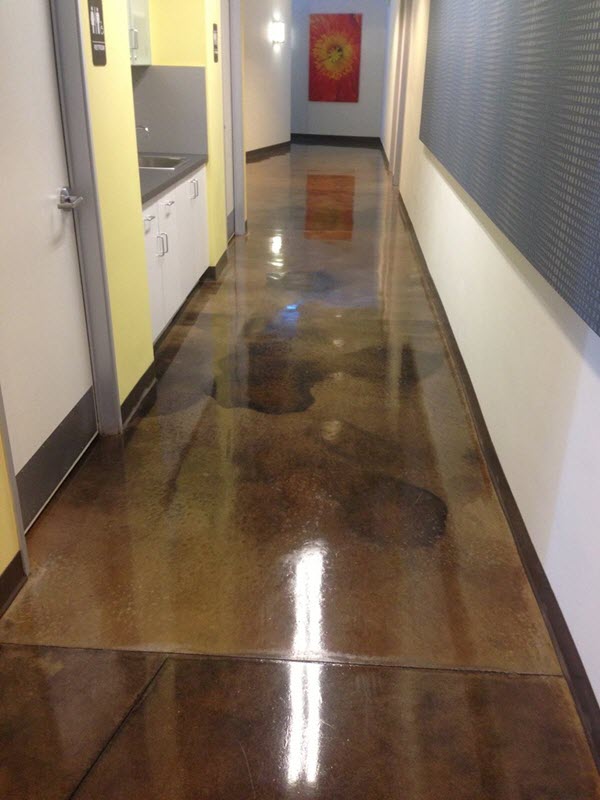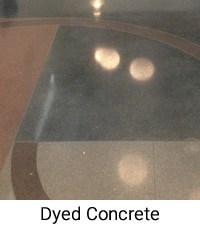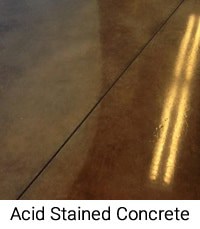What is Acid Staining?
Concrete acid staining yields colors that are elegant and mottled that are described by many as “rustic”. An acid stained polished concrete floor is very popular in commercial settings like office buildings and upscale retail stores. Acid stained concrete is also becoming more prevalent in higher end homes and condos.
Our Acid Staining Process
1) Suitability of the Concrete Slab
2) Concrete Moisture Testing
3) Apply Acid Stain
4) Neutralization of Acidic State
5) Sealing Your Acid Stained Floor
To protect your floor from wear and tear, and to preserve the beautiful new acid stain that was applied will use a commercial grade concrete sealer to protect your floor. The sealer protects your concrete from foot traffic and also prevents moisture from penetrating into your concrete slab.
Acid Stain Colors

More than One Color?
Different Colors in Different Parts of Your Concrete Floor
Combining Colors Together on Your Concrete Floor
Combining colors can yield somewhat unpredictable results as it may not be a perfect melding of the two colors. Darker acid stain colors tend to dominate lighter colors.
Acid Stained Concrete Floors Pros and Cons
Pros
- High End, Elegant Look – While you won’t get a solid color with acid stained concrete, what you do get is an amazing, unique look that will look fantastic.
- Durable – Sealed acid stained concrete floors are highly durable and can stand up to heavy traffic.
- Low Maintenance – Acid stained polished concrete floors are easy to clean and maintain. The lifetime ownership cost of acid stained floors is almost always lower than other alternatives like concrete coatings or tile.
Cons
- Color Selection – When compared to concrete dyes, the color selection for acid stained concrete floors is somewhat limited. Most colors are a variation of blue, green, brown, and red hues.
- Somewhat Unpredictable – while you can choose a color for your acid stain, the end result will match the color to some extent, but the patterns will be somewhat unpredictable. While this delivers a beautiful, elegant look, if you’re looking for a solid color with a known outcome, you should consider a concrete dye instead.
Concrete Dyes vs. Concrete Stains: What is the Difference?
- Give you a more consistent color within the concrete.
- Gives you variety of colors
- Good with logos

- Will give you a more mottled look within the color
- Rustic type look/results in various shades/tone within a color
- Stain is the acid reacting with the lime in the concrete

Acid Staining FAQs
What Happens if You Don't Neutralize Acid Stain Properly?
Not effectively neutralizing your acid stain can cause problems with the sealer properly adhering to and protecting your concrete floor.
How Long Does it Take to Acid Stain Concrete?
This will vary based on your project requirements and the condition of your concrete slab. Once the slab is fully prepared and ready to take the acid stain, our crew can generally complete the acid staining process within a day or two.
How Long Does Acid Stained Concrete Last?
Can You Acid Stain Old Concrete?
Yes, you can absolutely acid stain an old concrete slab. Just note that the concrete prep process may be more time consuming and costly to get the concrete floor into a state where it will readily be able to effectively accept the acid stain. For example, if your floor has an old, worn floor coating (like epoxy coating) it will have to be removed prior to the acid staining process.
Can You Acid Stain a Garage Floor or Concrete Driveway?
Is Concrete Acid Stain Permanent?
Is it Better to Paint or Acid Stain Concrete?
Acid Stain is a superior way to change the color of concrete that provides a permanent color change that won’t ever wear off. Commercial, Industrial and retail companies should consider either acid stain or concrete dyes to achieve their ideal floor color.
Painted concrete floors are susceptible to flaking and wearing out and require significant maintenance to keep your floors looking their best.